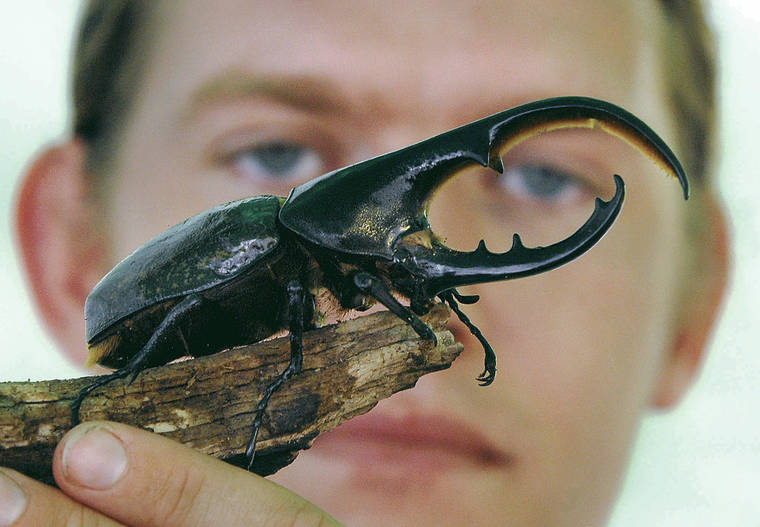Collectors pay high prices for big bugs

ASSOCIATED PRESS / JULY 20
A Budapest Zoo worker holds a large Hercules beetle at the annual insect day in Budapest, Hungary.
TOKYO >> Akio Ohara reaches into a plastic container and scoops out a beetle bigger than his hand. Its majestic top horn stretches out far past the tips of his fingers, and a smaller horn curves menacingly, primed on a set of powerful jaws.
“You’ve got to be careful it doesn’t pinch your finger,” Ohara said. “That would be very painful.”
He is holding a Hercules beetle, the longest species of beetle in the world, known to change hands for millions of yen.
Ohara is the owner of Beetle On, a specialty store in Tokyo’s Ota Ward that sells stag beetles and rhinoceros beetles, of which the Hercules beetle is one species. Business has been so brisk that the pandemic has barely affected his bottom line.
Rhinoceros and stag beetles have long been favorites with children and insect enthusiasts. Interest has surged in recent years, with families driving the trend.
“They’re really popular at the moment,” Ohara said, amid a backdrop of scratching sounds coming from rows of containers lining the racks in his store. “There are lots of shows featuring beetles on TV … and there have also been a lot of exhibitions at museums. They’re aimed at families, and you can go along and see the beetles and touch them and learn about them.”
Don't miss out on what's happening!
Stay in touch with breaking news, as it happens, conveniently in your email inbox. It's FREE!
The beetles start out as larvae and grow on a diet of decomposing wood and other organic matter. They change into pupae, from which the adult insects emerge. Their lifespans run from six months to a year.
Rhinoceros beetles, known for their characteristic long horns, can grow to nearly 7 inches. Stag beetles get as large as 4-1/2 inches and have large mandibles reminiscent of stag antlers.
Several smaller species are found in Japan, inhabiting wooded areas and feeding on tree sap. Ohara sells them for about $3.75. Larger species, usually from Southeast Asia and South and Central America, are much pricier. Hercules beetles typically run $470 to $938.
Of the many breeders in Japan, there is perhaps no bigger name than Hirofumi Kawano, better known as HirokA.
Kawano, a 51-year-old grape farmer from Miyazaki Prefecture, breeds Hercules beetles. When he saw one for the first time, it was love at first sight.
Kawano first learned to breed the beetles, then began experimenting with his own mixes of nutrient-rich wood chips for larvae. The stench from the decomposing matter he mixed in 10-gallon vats was so strong that he lost some of his ability to smell. But his beetles are prize winners.
In 2015, Kawano tied the world record for the longest Hercules beetle as judged by Be-Kuwa magazine, known as the beetle breeder’s bible. His entry measured a gargantuan 6.7 inches.
Now, he sells his own Hercules beetles and markets his HirokA wood-chip mix in Asia.
Kawano said his beetle empire is now bigger than his grape-farming business, and he built a breeding facility where he is raising 2,000 beetles. The highest price he’s garnered for one: $5,440.
With such big profits to be made, it’s no surprise that more people are taking an interest.
Next April, Sendai College of Eco and Animals plans to launch what it believes is Japan’s first insect breeding course. The three-year program will also teach students to find beetles in the wild and market their businesses.
“The reason we’re starting this course is because beetle breeding has been (flagged) by business magazines as (a venture) that will continue to grow,” said Tsuyoshi Iwasaki, the college’s admissions officer.
For some, the beauty of breeding lies in the journey, not the destination.
“You have to rear the eggs to get the larvae, then rear the larvae into adult beetles,” said Kawano. “For me, the enjoyment is in the whole breeding process. (When the beetles) have grown, you feel happy. You feel moved by how much they’ve grown.”



